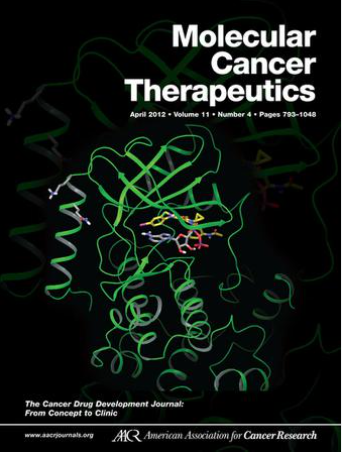Abstract IA009: Single strand DNA GAP accumulation as a functional biomarker for DNA Repair Inhibitors
IF 5.3
2区 医学
Q1 ONCOLOGY
引用次数: 0
Abstract
Deficiency of homologous recombination (HR)-mediated DNA repair occurs through genetic or epigenetic inactivation of the BRCA1 and BRCA2 (BRCA1/2) genes. HR-deficiency also provides unique opportunities for targeted therapy, through the mechanism of synthetic lethality, as exemplified by the hypersensitivity of BRCA1/2-mutated tumors to PARP inhibitors (PARPi). To date, several PARP inhibitors have been approved for clinical use. The promising clinical response of patients with germline BRCA1/2-mutations prompted the use of PARPi for patients with somatic BRCA1/2 mutations as well. In addition, these results extended the use of PARPi for various types of ovarian, breast, pancreatic, and prostate tumors with HR defects. PARPi resistance is emerging as the major obstacle to clinical effectiveness in patients with HR-deficient tumors. PARPi resistance results from several independent mechanisms, leading to the restoration of Homologous Recombination and/or Replication Fork stabilization. The absence of alternative options for patients with tumors with innate or acquired resistance underlines the urgency to develop additional therapeutics. More recent studies have identified new synthetic lethal opportunities for BRCA1/2 deficient tumors. Knockout of the genes for POLQ (DNA polymerase theta) or for USP1 (Ubiquitin Specific Protease 1) results in killing of these tumors, and inhibitors of these enzymes are emerging as promising agents for HR-deficient tumors. POLQ and USP1 expression is particularly high in subtypes of breast and ovarian tumors with defects in HR. As a result, POLQi or USP1i in HR-deficient tumors induces cell death. POLQi or USP1i can synergize with PARPi in killing HR-deficient tumors or PARPi-resistant tumors. BRCA1/2 deficient tumors have an increase in single strand DNA gaps (ssGAPs) near replication forks. Treatment with PARPi results in an increase in the size and number for these ssGAPs, ultimately leading to DSBs and cell death. Interestingly, PARPi resistance results, at least in part, from the ability of resistant cells to close the ssGAPs through enhanced POLQ and USP1 activity, thereby providing a rationale for the combination of PARP1, POLQi, and USP1 in HR-deficient cancers. USP1 inhibition was synergistic with PARP and POLQ inhibition in BRCA1-mutant cells, with enhanced ssDNA gap accumulation. Moreover, this synergy was observed in a set of patient-derived ovarian cancer organoids (PDOs), thus confirming the sensitivity of BRCA1-deficient cells to inhibition by these agents. The accumulation of ssDNA gaps after treatment with a USP1i, PARP, or POLQi correlated with the sensitivity to these drugs in all models tested. Ovarian cancer PDOs provide a powerful tool for detecting drug synergy and for rapid in vitro sensitivity testing. The detection of ssDNA gap accumulation may be a useful predictive biomarker for response to DNA Repair inhibitors as monotherapy or in combination in ongoing clinical trials. Citation Format: Alan D. D'Andrea. Single strand DNA GAP accumulation as a functional biomarker for DNA Repair Inhibitors [abstract]. In: Proceedings of the AACR Special Conference in Cancer Research: Expanding and Translating Cancer Synthetic Vulnerabilities; 2024 Jun 10-13; Montreal, Quebec, Canada. Philadelphia (PA): AACR; Mol Cancer Ther 2024;23(6 Suppl):Abstract nr IA009.摘要 IA009:作为 DNA 修复抑制剂功能生物标记的单链 DNA GAP 积累
BRCA1和BRCA2(BRCA1/2)基因的遗传或表观遗传失活会导致同源重组(HR)介导的DNA修复缺陷。通过合成致死机制,HR缺陷也为靶向治疗提供了独特的机会,BRCA1/2基因突变的肿瘤对PARP抑制剂(PARPi)过敏就是一个例子。迄今为止,已有几种 PARP 抑制剂被批准用于临床。种系 BRCA1/2 基因突变患者良好的临床反应促使人们也将 PARPi 用于体细胞 BRCA1/2 基因突变患者。此外,这些结果还将 PARPi 的使用范围扩大到了具有 HR 缺陷的各种类型的卵巢、乳腺、胰腺和前列腺肿瘤。PARPi 耐药性正成为 HR 缺陷肿瘤患者获得临床疗效的主要障碍。PARPi 耐药性是由几种独立机制导致的,这些机制导致同源重组和/或复制叉稳定的恢复。对于具有先天或获得性耐药性的肿瘤患者来说,缺乏替代选择凸显了开发其他疗法的紧迫性。最近的研究为 BRCA1/2 缺乏性肿瘤找到了新的合成致死机会。POLQ(DNA聚合酶θ)或USP1(泛素特异性蛋白酶1)基因的敲除可杀死这些肿瘤,而这些酶的抑制剂正成为治疗HR缺陷型肿瘤的有前途的药物。在存在 HR 缺陷的乳腺和卵巢肿瘤亚型中,POLQ 和 USP1 的表达量尤其高。因此,HR缺陷肿瘤中的POLQi或USP1i可诱导细胞死亡。POLQi 或 USP1i 可与 PARPi 协同杀死 HR 缺陷肿瘤或 PARPi 抗性肿瘤。缺乏 BRCA1/2 的肿瘤在复制叉附近的单链 DNA 间隙(ssGAPs)会增加。用 PARPi 治疗会导致这些 ssGAP 的大小和数量增加,最终导致 DSB 和细胞死亡。有趣的是,PARPi 的耐药性至少部分源于耐药细胞通过增强 POLQ 和 USP1 的活性关闭 ssGAP 的能力,从而为在 HR 缺陷癌症中结合使用 PARP1、POLQi 和 USP1 提供了理论依据。在 BRCA1 突变细胞中,USP1 抑制与 PARP 和 POLQ 抑制具有协同作用,ssDNA 间隙积累增强。此外,在一组来源于患者的卵巢癌器官组织(PDOs)中也观察到了这种协同作用,从而证实了 BRCA1 基因缺陷细胞对这些药物抑制的敏感性。在所有测试模型中,USP1i、PARP 或 POLQi 处理后 ssDNA 间隙的积累与对这些药物的敏感性相关。卵巢癌 PDO 为检测药物协同作用和快速体外敏感性测试提供了有力的工具。在正在进行的临床试验中,检测ssDNA间隙累积可能是预测DNA修复抑制剂单药或联合用药反应的有用生物标志物。引用格式:Alan D. D'Andrea.作为 DNA 修复抑制剂功能性生物标志物的单链 DNA GAP 累积 [摘要]。In:AACR 癌症研究特别会议论文集:扩展和转化癌症合成脆弱性;2024 年 6 月 10-13 日;加拿大魁北克省蒙特利尔。费城(宾夕法尼亚州):AACR; Mol Cancer Ther 2024;23(6 Suppl):Abstract nr IA009.
本文章由计算机程序翻译,如有差异,请以英文原文为准。
求助全文
约1分钟内获得全文
求助全文
来源期刊
CiteScore
11.20
自引率
1.80%
发文量
331
审稿时长
3 months
期刊介绍:
Molecular Cancer Therapeutics will focus on basic research that has implications for cancer therapeutics in the following areas: Experimental Cancer Therapeutics, Identification of Molecular Targets, Targets for Chemoprevention, New Models, Cancer Chemistry and Drug Discovery, Molecular and Cellular Pharmacology, Molecular Classification of Tumors, and Bioinformatics and Computational Molecular Biology. The journal provides a publication forum for these emerging disciplines that is focused specifically on cancer research. Papers are stringently reviewed and only those that report results of novel, timely, and significant research and meet high standards of scientific merit will be accepted for publication.

 求助内容:
求助内容: 应助结果提醒方式:
应助结果提醒方式:


